TwinBee (ツインビー) is a video game series composed primarily of cartoon-themed vertical-scrolling shoot-'em-up games produced by Konami that were released primarily in Japan. The series originated as a coin-operated video game simply titled TwinBee in 1985, which was followed by several home versions and sequels. The character designs of almost every game in the series since Detana!! TwinBee in 1991 were provided by Japanese animator Shuzilow HA, who also planned and supervised most of the subsequent installments in the TwinBee series. The series also inspired a radio drama adaptation that lasted three seasons in Japan, as well as an anime adaptation.

Ganbare Goemon, known as Goemon and Mystical Ninja internationally, is a video game series created and produced by Konami. Etsunobu Ebisu is the joint producer of the franchise.
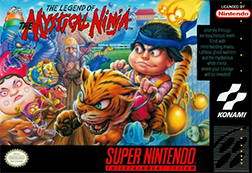
The Legend of the Mystical Ninja, known as Ganbare Goemon: Yukihime Kyūshutsu Emaki in Japan, is an action-adventure game by Konami, and was released for the Super Nintendo Entertainment System in 1991. It was also ported to the Game Boy Advance along with Ganbare Goemon 2: Kiteretsu Shōgun Magginesu only in Japan.

Mystical Ninja Starring Goemon is a platform action-adventure video game released by Konami for the Nintendo 64 on August 7, 1997 in Japan, April 16, 1998 in North America, and 18 April 1998 in Europe as the fifth entry in the Ganbare Goemon series. The second Goemon game released in North America and Europe, it follows The Legend of the Mystical Ninja and features hybrid elements of platform games and action-adventure games.

Goemon's Great Adventure, known as Mystical Ninja 2 Starring Goemon in Europe, is a video game developed and released by Konami for the Nintendo 64 on December 23, 1998. It is the third game in the Ganbare Goemon series released in North America and Europe, following Mystical Ninja Starring Goemon, released two years earlier. Featuring platform gameplay in 2.5D, it returns the series to a side-scrolling format.
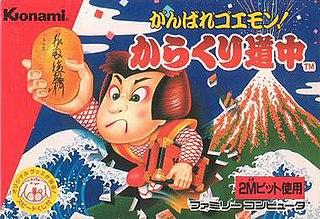
Ganbare Goemon! Karakuri Dōchū is a video game produced by Konami. It is the second game in the Ganbare Goemon series and the first to be released on a video game console and home computer. It was initially released for the Family Computer on July 30, 1986 and later released for the MSX2 a year later. The Famicom version was re-released in Japan only for the Game Boy Advance under the Famicom Mini label and for the Wii, Nintendo 3DS and Wii U under the Virtual Console service. A direct sequel, Ganbare Goemon 2, was released for the Famicom on January 4, 1989.

Parodius: The Octopus Saves the Earth, also known as Parodius, is a scrolling shooter video game developed by Konami for the MSX computer and was released in Japan. The game is notable for being the first title in the Parodius series, although it is often confused with its sequel Parodius! From Myth to Laughter. The name itself is a portmanteau of "Gradius" and "Parody" and, eponymously, the game is a parody of the Gradius series of space-based horizontally scrolling shooters. Many of the characters and enemies are derived from that famous shooter series, while other elements are extracted from other Konami titles, such as Antarctic Adventure and TwinBee. This game is of particular note in the series as being heavily infused with Japanese culture and folklore.

Konami Wai Wai World, "wai wai" being a Japanese onomatopoeia for a noisy, crowded area, is a 1988 Family Computer platform video game released only in Japan by Konami. The game itself stars various Konami-created characters as well as Mikey and King Kong, who appeared in two Konami-produced, film-based games.

Wai Wai World 2: SOS!! Parsley Jō is a 1991 Famicom platform game released only in Japan by Konami. It is a sequel to Konami Wai Wai World, and stars various Konami characters. It was also re-released for the Wii U Virtual Console on September 2, 2015 in Japan.
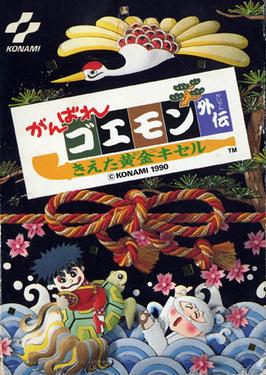
Ganbare Goemon Gaiden: Kieta Ōgon Kiseru is a video game in the Ganbare Goemon series, released for the Family Computer on January 5, 1990 in Japan. In the story, Goemon is searching for his missing pipe. This game introduced many characters that appeared later in the series, such as Yae. It is the first Goemon role-playing game, and the third Goemon game to appear on a Nintendo system.

Goemon: Mononoke Sugoroku is a video game for the Nintendo 64, released by Konami in 1999. It is the third Ganbare Goemon game released for the Nintendo 64, and the only one of the three to not be released outside of Japan.

Ganbare Goemon: Kuru Nara Koi! Ayashige Ikka no Kuroi Kage is a Ganbare Goemon game released for the PlayStation on December 23, 1998. It was released alongside Goemon's Great Adventure for the Nintendo 64. It was the second game in the series released for the PlayStation and also the second game in 3D, following Mystical Ninja Starring Goemon.
Konami GB Collection is a series of video game compilations composed of four volumes released in Japan for the Game Boy and re-released in Euro regions for the Game Boy Color. The compilations were originally released from 1997 to 1998 in Japan, and were later released in Europe in 2000.
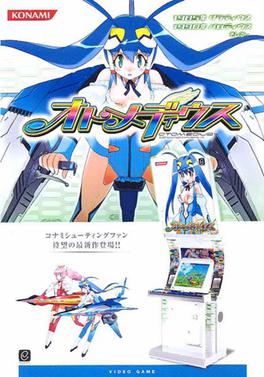
Otomedius is a side scrolling shooter by Konami which featured personification of space fighters from various Konami games. The name is a pun, being a portmanteau of the terms "Otome" and "Gradius", with a set of equipment resembling space fighters from Gradius.
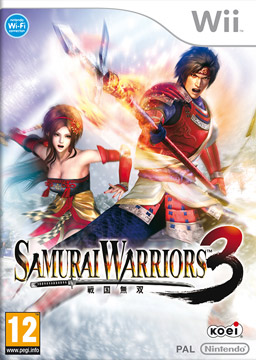
Samurai Warriors 3 is the third installment in the Samurai Warriors series, created by Tecmo Koei and Omega Force. The game was released in Japan on December 3, 2009, in Europe on May 28, 2010, in Australia on June 10, 2010, and in North America on September 28, 2010, for the Wii.
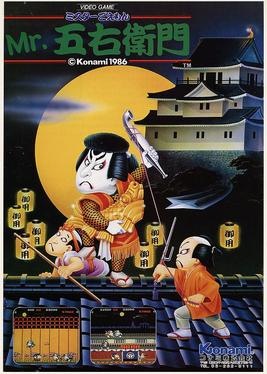
Mr. Goemon is a platform game developed by Konami and released in arcades in 1986. The side-scrolling game is based on Ishikawa Goemon, an outlaw in 16th-century Japan. It is the first game in the Ganbare Goemon series.

Jikkyō Power Pro Wrestling '96: Max Voltage is a 1996 pro wrestling video game by Konami, released exclusively in Japan for the Super Famicom.
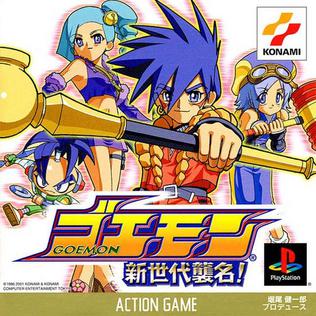
Goemon: Shin Sedai Shūmei! is an action platforming game in the Ganbare Goemon series released for the PlayStation on December 20, 2001 in Japan. Developed by Konami Computer Entertainment Tokyo and Now Production, it is a futuristic spin-off of the original Ganbare Goemon series starring new characters who inherit the namesakes of the original cast in a more modern setting.

Konami Wai Wai Sokoban (コナミワイワイ倉庫番) is a game of wits, Sokoban style mobile phone game which was published by Konami only in Japan in the i-mode platform and Yahoo! Keitai. It is the fourth game in the Konami Wai Wai series, and as it is traditional, it brings together popular characters from other Konami games.

Super Bomberman R is an action-maze game developed by Konami and HexaDrive and published by Konami. The game was first released worldwide as a launch title for the Nintendo Switch in March 2017, and later for PlayStation 4, Windows, and Xbox One in June 2018. Part of the Bomberman franchise, it is the sixth installment of the Super Bomberman series and the first game in the series to be released in twenty years. It is also the first Bomberman entry in the franchise to be developed for consoles following the dissolution of original series owner Hudson Soft in 2012.


















